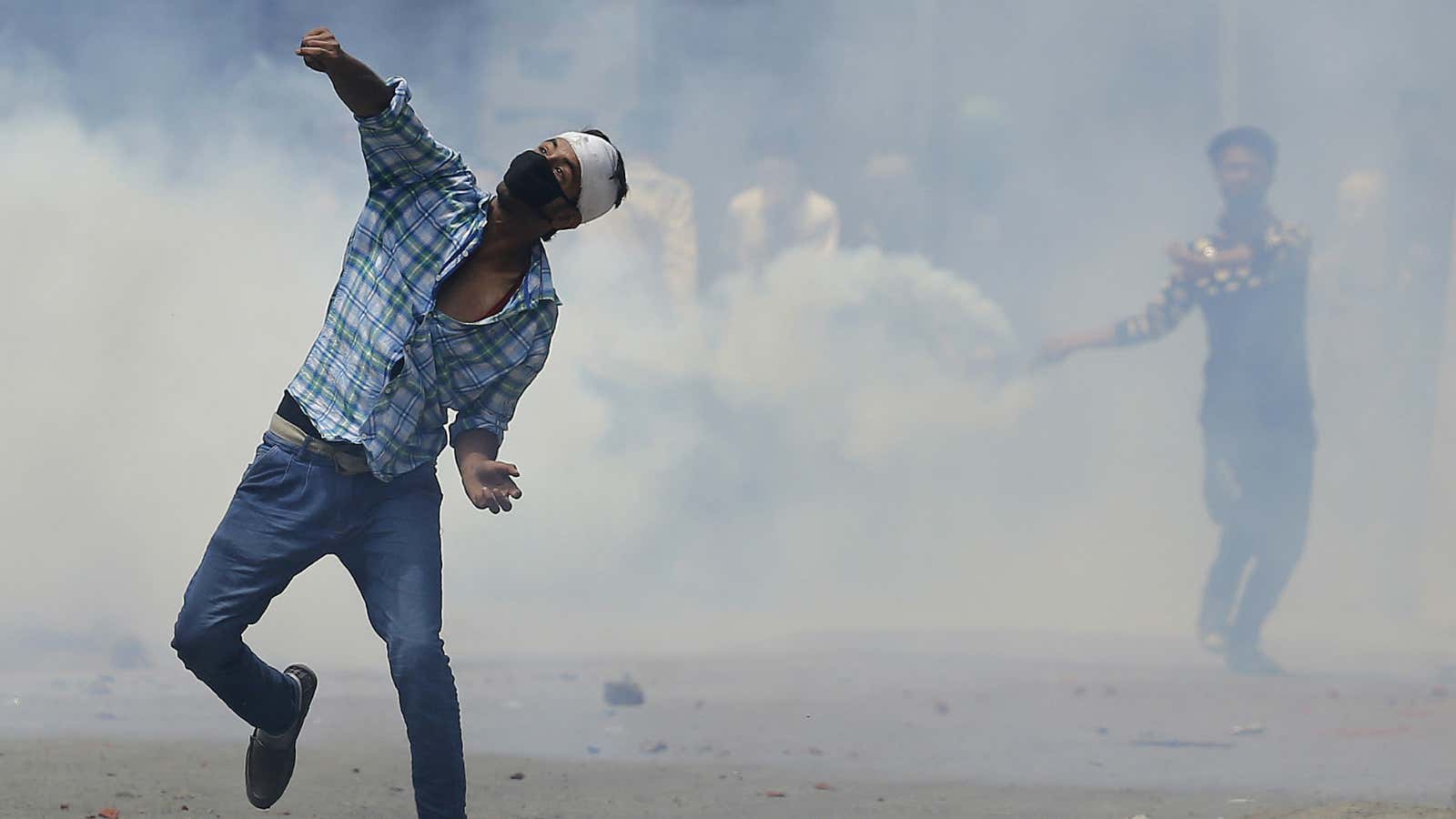Kashmir is simmering again.
With more than 20 deaths reported over the past three days, the Kashmir valley is witnessing yet another summer of rage.
Violence erupted after the death of Burhan Muzaffar Wani, a 22-year-old militant commander of the Hizbul Mujahideen, on Friday (July 08). Since then, the situation has turned unpredictable as each new death is only fuelling further anger.
Seething crowds have pelted stones and attacked security installations. In return, security forces have used teargas canisters, pellets, and even bullets. Protesters, mostly young men, have died. A policeman, too, was killed.
But why are Kashmir’s young so angry?
Lack of political will
To some observers, this is nothing new. People have protested and participated in funeral processions of militants for years—the largest being that of the Jammu Kashmir Liberation Front commander, Ashfaq Majeed Wani, in 1990.
“The people of Kashmir see India as an aggressor and an occupier. It is occupying this land against their wishes,” said Showkat A Motta, editor-in-chief of The Kashmir Narrator, a Srinagar-based magazine.
“Nothing has changed as far as (the) Kashmir struggle is concerned. Only the resistance movement has passed on from one generation to the other,” Motta said.
There is a feeling among ordinary Kashmiris and political commentators that India hasn’t shown enough seriousness in resolving the Kashmir issue politically, except on two occasions.
The first was in the 1990s. As violence flared with the rise of an armed insurgency, the government of India sent an all-party delegation led by George Fernandes. The second was the arrival of a parliamentary committee in 2010 led by then home minister P. Chidambaram.
But very little came of those two engagements.
Instead, Kashmir is often described merely as a “law and order” problem. A brief lull in violence is portrayed as “normalcy.”
Muzzled the youth
Frustration has been steadily building among a generation that has lived almost its entire life under militancy and militarisation.
There is little space left in Kashmir for most people to express their political aspirations. Over the years, protests have been quelled with an iron hand, and the arbitrary use of the Public Safety Act (PSA) to book young people has become the norm.
Following the 2010 agitations, during which over 120 youths were killed, hundreds of young Kashmiris were booked under PSA and other charges. Even after their release from police station—and in some cases, from jails—authorities repeatedly summoned many whenever there was any disturbance.
“When you muzzle the popular sentiment with brute force then there are consequences as we are witnessing today,” said Ali Mohammad Sagar, a senior leader of Kashmir’s oldest mainstream pro-India party, National Conference, which is now in opposition.
“Our government made a mistake, and now the present regime is making a similar one,” Sagar said. “We are not listening to our youth. We don’t let them say anything.”
Rising militancy
After the 9/11 attacks in the US, the pro-freedom camp in Kashmir began backing the political process and dialogue as a viable option, while putting the armed struggle on the back-burner.
“Fearing that the armed struggle in Kashmir may be linked to the global militant networks, the pro-freedom leaders portrayed the Kashmir struggle as an indigenous peoples’ movement,” explained a political analyst, requesting anonymity.
But the strategy failed after the inability of pro-freedom leaders to utilise the mass public movements of 2008, 2009, and 2010. Many were confined to their home, and the government’s response to protests was brutal.
As a result, armed struggle once again took centre-stage. Militants like Wani filled the vacuum.
“With more and more educated local youth from well-off and influential families joining militancy, the support of general masses grew,” he added. “Effective use of social media helped militants garner further support in other parts of the valley.”
It is argued by some quarters that unemployment pushed the Kashmiri youth towards militancy, but those who have joined the militancy in the recent past have come from economically sound families. Some had engineering and post-graduate degrees. A few chose to even abandon government jobs to join the new breed of militants.
Security forces
The reaction of the security forces has only worsened the situation. With their disproportionate use of force in 2008, 2009, 2010, and now again this year, the Jammu and Kashmir police are increasingly seen as aggressors.
The continued application of the Armed Forces Special Powers Act (AFSPA) in Kashmir has also been a contentious issue, especially concerning alleged atrocities perpetrated by security forces. The police, though, are out of its ambit.
“The AFSPA doesn’t apply to Jammu and Kashmir Police, still we have seen (that) not even a single policeman has been penalised for (the) killing of youths in 2008, 2009, and 2010,” the political analyst said. “There is an absolute absence of justice when it comes to acting against the security forces.”
That the police failed to comply with the standard operating procedures (SOPs) when dealing with unarmed protestors was recently even acknowledged by Mehbooba Mufti, the Jammu and Kashmir chief minister and leader of the People’s Democratic Party (PDP).
The PDP, which currently holds power in coalition with the Bharatiya Janata Party, may have also rubbed ordinary Kashmiris the wrong way. Recent suggestions to create colonies for ex-servicemen, implementation of a controversial industrial policy, and the establishment of separate townships for displaced Kashmiri Pandits have been viewed with suspicion.
The killing of Burhan Wani has simply unleashed the anger brewing inside.
